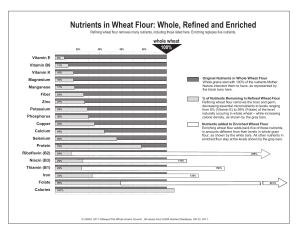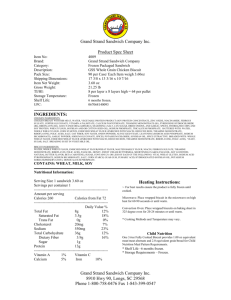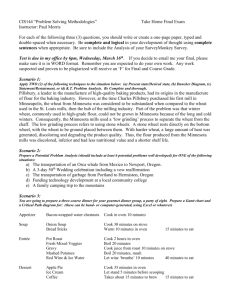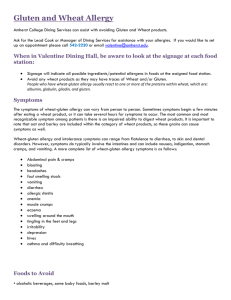The State of Science Regarding Consumption of Refined and
advertisement
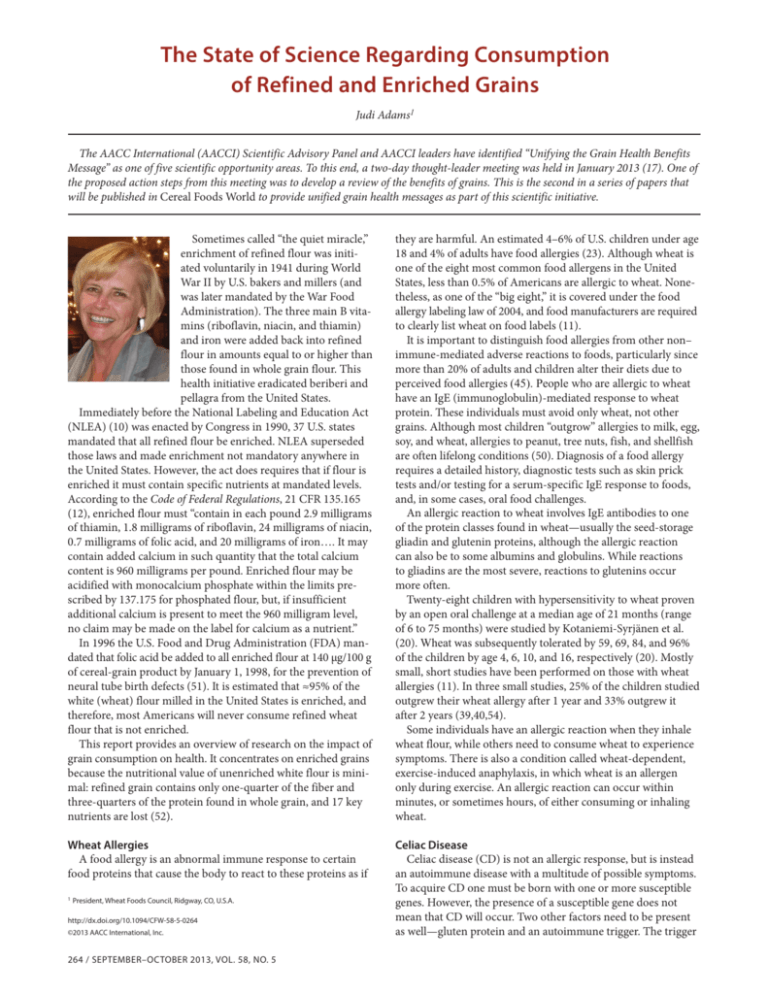
The State of Science Regarding Consumption of Refined and Enriched Grains Judi Adams1 The AACC International (AACCI) Scientific Advisory Panel and AACCI leaders have identified “Unifying the Grain Health Benefits Message” as one of five scientific opportunity areas. To this end, a two-day thought-leader meeting was held in January 2013 (17). One of the proposed action steps from this meeting was to develop a review of the benefits of grains. This is the second in a series of papers that will be published in Cereal Foods World to provide unified grain health messages as part of this scientific initiative. Sometimes called “the quiet miracle,” enrichment of refined flour was initiated voluntarily in 1941 during World War II by U.S. bakers and millers (and was later mandated by the War Food Administration). The three main B vitamins (riboflavin, niacin, and thiamin) and iron were added back into refined flour in amounts equal to or higher than those found in whole grain flour. This health initiative eradicated beriberi and pellagra from the United States. Immediately before the National Labeling and Education Act (NLEA) (10) was enacted by Congress in 1990, 37 U.S. states mandated that all refined flour be enriched. NLEA superseded those laws and made enrichment not mandatory anywhere in the United States. However, the act does requires that if flour is enriched it must contain specific nutrients at mandated levels. According to the Code of Federal Regulations, 21 CFR 135.165 (12), enriched flour must “contain in each pound 2.9 milligrams of thiamin, 1.8 milligrams of riboflavin, 24 milligrams of niacin, 0.7 milligrams of folic acid, and 20 milligrams of iron…. It may contain added calcium in such quantity that the total calcium content is 960 milligrams per pound. Enriched flour may be acidified with monocalcium phosphate within the limits prescribed by 137.175 for phosphated flour, but, if insufficient additional calcium is present to meet the 960 milligram level, no claim may be made on the label for calcium as a nutrient.” In 1996 the U.S. Food and Drug Administration (FDA) mandated that folic acid be added to all enriched flour at 140 μg/100 g of cereal-grain product by January 1, 1998, for the prevention of neural tube birth defects (51). It is estimated that ≈95% of the white (wheat) flour milled in the United States is enriched, and therefore, most Americans will never consume refined wheat flour that is not enriched. This report provides an overview of research on the impact of grain consumption on health. It concentrates on enriched grains because the nutritional value of unenriched white flour is minimal: refined grain contains only one-quarter of the fiber and three-quarters of the protein found in whole grain, and 17 key nutrients are lost (52). they are harmful. An estimated 4–6% of U.S. children under age 18 and 4% of adults have food allergies (23). Although wheat is one of the eight most common food allergens in the United States, less than 0.5% of Americans are allergic to wheat. Nonetheless, as one of the “big eight,” it is covered under the food allergy labeling law of 2004, and food manufacturers are required to clearly list wheat on food labels (11). It is important to distinguish food allergies from other non– immune-mediated adverse reactions to foods, particularly since more than 20% of adults and children alter their diets due to perceived food allergies (45). People who are allergic to wheat have an IgE (immunoglobulin)-mediated response to wheat protein. These individuals must avoid only wheat, not other grains. Although most children “outgrow” allergies to milk, egg, soy, and wheat, allergies to peanut, tree nuts, fish, and shellfish are often lifelong conditions (50). Diagnosis of a food allergy requires a detailed history, diagnostic tests such as skin prick tests and/or testing for a serum-specific IgE response to foods, and, in some cases, oral food challenges. An allergic reaction to wheat involves IgE antibodies to one of the protein classes found in wheat—usually the seed-storage gliadin and glutenin proteins, although the allergic reaction can also be to some albumins and globulins. While reactions to gliadins are the most severe, reactions to glutenins occur more often. Twenty-eight children with hypersensitivity to wheat proven by an open oral challenge at a median age of 21 months (range of 6 to 75 months) were studied by Kotaniemi-Syrjänen et al. (20). Wheat was subsequently tolerated by 59, 69, 84, and 96% of the children by age 4, 6, 10, and 16, respectively (20). Mostly small, short studies have been performed on those with wheat allergies (11). In three small studies, 25% of the children studied outgrew their wheat allergy after 1 year and 33% outgrew it after 2 years (39,40,54). Some individuals have an allergic reaction when they inhale wheat flour, while others need to consume wheat to experience symptoms. There is also a condition called wheat-dependent, exercise-induced anaphylaxis, in which wheat is an allergen only during exercise. An allergic reaction can occur within minutes, or sometimes hours, of either consuming or inhaling wheat. Wheat Allergies A food allergy is an abnormal immune response to certain food proteins that cause the body to react to these proteins as if Celiac Disease Celiac disease (CD) is not an allergic response, but is instead an autoimmune disease with a multitude of possible symptoms. To acquire CD one must be born with one or more susceptible genes. However, the presence of a susceptible gene does not mean that CD will occur. Two other factors need to be present as well—gluten protein and an autoimmune trigger. The trigger 1 President, Wheat Foods Council, Ridgway, CO, U.S.A. http://dx.doi.org/10.1094/CFW-58-5-0264 ©2013 AACC International, Inc. 264 / SEPTEMBER–OCTOBER 2013, VOL. 58, NO. 5 is usually an infection, but it can be any extreme stress, including psychological stress. To determine if one has CD, a blood test is needed, and if it is positive, then an intestinal biopsy is essential to confirm a CD diagnosis. Less than 1% of the U.S. population, or 3 million Americans (1 in 133), is affected by CD. There has been a rise in diagnosed cases, which has been attributed to heredity and may be partially due to improved testing methods and greater awareness on the part of the public and health professionals. Several other environment-based theories are currently being researched: Less breast feeding (antibodies are not passed to the infant) Introducing gluten too early or in too large quantities to infants who are no longer breast feeding (15,42) Keeping a child’s environment too aseptic (they don’t build up antibodies) Added gluten in the food supply Shortened fermentation times for commercial breads (14) Food-borne infections and viruses Increased incidence of cesarean births (infants do not receive bacterial flora during birth) (28) Excessive use of antibiotics and antacids Excessive salt intake (19) Changes in gut bacteria (41,43,55) Non-celiac Gluten Sensitivity Non-celiac gluten sensitivity (NCGS) is a new name for those who are sensitive to gluten and show some of the same symptoms as those with CD but who do not have a susceptible gene or damage to their intestinal tract (26). A gluten-free diet may be necessary to eliminate symptoms; however, some people with NCGS may be able to tolerate a minimal intake of gluten. The Center for Celiac Research and Treatment at Massachusetts General Hospital estimates that as much as 6% of the population may have NCGS (www.celiaccenter.org), while other researchers give estimates as low as 1% (7). There currently is no test for gluten sensitivity (www.bidmc.org). Gluten Quantity and Quality In spite of claims about the quality and quantity of gluten in modern wheat varieties, scientific evidence indicates there was no change in the gluten content of wheat in the United States during the 20th century (18). According to the U.S. Wheat Associates (“On-farm Protein 1979–2011”), the quantity of protein has stayed the same for 30 years, although this obviously does not equate with the quality of the gluten. Elsewhere, research conducted in the Netherlands (49) has found increased gliadin in 36 modern varieties of wheat compared with 50 older varieties. The Glia-9 epitope content was higher and the Glia20 epitope content was lower in modern varieties compared with older varieties. Both modern and older varieties were identified that have relatively low contents of both epitopes, which might provide opportunities for breeding wheat varieties that are better tolerated (49). A 2011 study in Europe concluded that breeding for yield and protein quality has been neutral for other grain components (44). Similar research has not been done in the United States, and the varieties and breeding are completely different, even between the United States and Canada. More research in this area must be conducted. Acrylamide Acrylamide was revealed as major threat to the carbohydrate industry in 2002 when a Swedish study reported major amounts were found in the food supply (46). The International Agency for Cancer Research has classified acrylamide as a probable carcinogen in humans and a neurotoxin. It has also been shown to be a carcinogen and genotoxin in animals (22). Acrylamide is formed at temperatures above 120°C when the amino acid asparagine reacts with carbohydrate foods as one of the many reactions that occur during the Maillard browning process. Thus, it has been present in the food supply since humans began cooking with fire. Foods in the American diet with the largest amounts of acrylamide include French fries, potato chips, cereal products, and brewed coffee; however, acrylamide can be formed in any food. Therefore, elimination of any food group will not eradicate this compound from the diet. Manufacturers around the world have been working to reduce acrylamide in their products and have been quite successful. To date, no country has set regulatory limits on acrylamide in foods because there is not enough conclusive evidence to support it. Acrylamide is a chemical that is regularly reviewed in Europe, the United States, and Canada; however, until more research suggests dietary guidance should change, the current recommendations will remain in place. Microbes in Wheat and Wheat Flour Wheat and wheat flour are subject to contamination by the numerous microbial agents with which they come in contact during growing and processing. They have low moisture levels, so it has been assumed that they cannot support bacterial growth and that even if bacteria is present cooking eliminates it (21). However, Eglezos (6) discovered that even though wheat and wheat flour cannot support bacterial growth at normal moisture levels, bacteria can remain dormant for years. This was verified recently when 77 people in 30 states contracted E. coli from eating commercially available raw cookie dough. It was suggested that the wheat flour in the dough was the source (32). According to a 2011 survey by ConAgra Mills, more than half of U.S. consumers have tasted raw commercial cookie dough, and 80% have licked the beaters or eaten raw dough when making baked goods at home (4). This suggests that consumers are not aware of the risks they are taking. Because the industry has only recently been made aware of these concerns, new treatments and sanitation techniques at the mill and processing, packaging, shipping, and storage facilities are still being sought (38). It is notable that refined and enriched grains generally contain lower levels of heavy metals, mycotoxins, pesticides, and other mycotoxins because the outer layers of the kernel have been removed (31). Glycemic Index and Glycemic Load The glycemic index (GI) and glycemic load (GL) of enriched (and whole) grains have often been portrayed as negative attributes, and the health impacts of altering glycemic response remain a source of controversy for most health outcomes. Possible exceptions may include those with diabetes, certain populations, such as sedentary and overweight or obese women, and insulin resistant individuals (13). GI is defined as the incremental area under the blood glucose response curve of 50 g of available carbohydrate of a test food, expressed as a percentage of the response to the same amount of CEREAL FOODS WORLD / 265 carbohydrate from 50 g of glucose ingested by the same subject. GL takes into consideration the quantity of food in addition to GI and, therefore, may be a more realistic measurement. GL is calculated by multiplying GI by the number of grams of carbohydrate in a serving of food. Each person’s glycemic response varies considerably from that of other people and from day to day even when the same food is eaten. Glycemic response also varies according to the meal eaten previously or even the night before (35). For example, when caffeine was consumed during a meal of either high- or low-GI cereals, blood glucose levels rose 147 or 216% higher, respectively (34). Variability is also caused by the content and type of sugars in a food, the proportion of amylose and amylopectin and whether the starch in a food is raw or gelatinized, the kind and degree of cooking and processing of a food, and whether the food is eaten hot or cold and alone or with other foods. Foods eaten a day or more prior to the test, the degree of chewing, and the speed of ingestion and whether glucose and insulin secretion are normal also change the glycemic response (16). Finally, fat and protein lower the glycemic response to foods, which can lower the GI of a food if it is fried (e.g., French fried versus baked potatoes) or if it delivers a high quantity of protein. Using GI to choose foods is not recommended by the 2005 and 2010 U.S. Dietary Guidelines for Americans because research has not shown it to be linked to body weight or other health outcomes (48). Increased cereal fiber content, on the other hand, is associated with lower body mass index (BMI), reduced risk of type 2 diabetes, and cardiovascular disease and is more indicative of a health-promoting diet than is use of GI or GL to select diets. Loss of Vitamins and Minerals in Processing Vitamins, minerals, and fiber are lost during the milling process, resulting in lower levels in refined grains than in whole grains. However, enriched grains contain 2 times more folic acid and riboflavin and 1.5 times more thiamin riboflavin and have been credited with eradicating pellagra and beriberi in the United States. Neural tube birth defects have also decreased by one-third since folic acid fortification of enriched grains was mandated by the FDA in 1998. The Centers for Disease Control and Prevention named this fortification mandate as one of the top 10 most successful health initiatives of the first decade of the 21st century (3). Canada has experienced a 46% reduction in neural tube birth defects during the same time period as a result of folic acid fortification of enriched grains (5,24,36,37). Chile began fortifying wheat flour with folic acid in 2000 and has reduced spina bifida by ≈55%, while Argentina has reduced its incidence by 48% (25). Costa Rica reports a 60% reduction in spina bifida (2) and Oman a 70% decrease related to folic acid fortification (1). In the United States, the 36% decrease in neural tube birth defects due to folic acid fortification has resulted in a total savings of $4.7 billion in direct healthcare costs (8). The Flour Fortification Initiative reports a decrease in neural tube birth defects of 30 to 70% in the 57 countries around the world that are fortifying flour with folic acid (9). In April 2012, the Gruma Corporation and five public service organizations petitioned the FDA to allow corn masa flour to be fortified with folic acid at the same level as wheat flour (27). The Hispanic population experiences a disproportionately higher incidence of neural tube birth defects and consumes less folic acid in wheat flour because masa flour products often replace wheat flour products in the Hispanic diet. Overall Effects of Enriched Grains in the Diet Contrary to urban legend, a 2012 Nutrition Reviews article (53) reports that enriched grains are not detrimental to a balanced diet. In the article, Williams (53) reviewed 135 relevant articles published between 2000 and 2010 and concluded, “The totality of evidence shows that consumption of up to 50% of all grain foods as refined-grain foods (without high levels of added fat, sugar or sodium) is not associated with any increased disease risk.” (However, he also highly recommends increased consumption of whole grains). Two studies from the Framingham Offspring Cohort were used to support Williams’ conclusions. The first study (2,941 An ad appeared here in the print version of the journal 266 / SEPTEMBER–OCTOBER 2013, VOL. 58, NO. 5 participants) found no negative association between BMI, waist-to-hip circumference, blood pressure, lipids, insulin, or glucose with servings of enriched grain at the highest quintile (5.5 servings/day) (30). The second study (2,834 subjects) found that enriched grains had no increased relationship with metabolic syndrome or insulin resistance (29). The Baltimore Longitudinal Study of Aging showed no relationship between enriched-grain intake at the highest quintile (103 g/day) with BMI, waist-to-hip circumference, blood pressure, overweight, cholesterol, or fasting glucose in 1,516 subjects (33). Adding further weight to the argument for the benefits of enriched grains in the diet, the 2010 Dietary Guidelines for Americans (47), which are based on scientific research, recommends the consumption of both whole and enriched grains. 16. 17. 18. 19. 20. Acknowledgments My sincere thanks to Julie Miller Jones for reviewing this report. 21. References 1. Alasfoor, D. Spina bifida and birth outcomes before and after fortification of flour with iron and folic acid in Oman. E. Mediterr. Health J. 16:533, 2010. 2. Barboza Arguello, M. P., and Umana, L. M. Impacto de la fortificacaión de alimentos con ácido fólico en los defectos del tubo neural en Costa Rica. Rev. Panam. Salud Publica 30(1):1, 2011. 3. Centers for Disease Control and Prevention. Ten great public health achievements—U.S. 2001–2010. CDC MMWR 60:619, 2011. 4. ConAgra Mills. The raw truth about consumer eating habits. Published online at www.conagramills.com/media/Food%20Habits%20of%20American%20Consumers%20Final.pdf. ConAgra Mills, Omaha, NE, 2011. 5. De Wals, P., Tairou, F., Van Allen, M. I., Uh, S.-H., Lowry, B., et al. Reduction in neural-tube defects after folic acid fortification in Canada. N. Engl. J. Med. 357:135, 2007. 6. Eglezos, S. Microbiological quality of wheat grain and flour from two mills in Queensland, Australia. J. Food Prot. 73:1533, 2010. 7. Fasano, A., and Guandalini, S. Understanding Gluten Related Disorders: Is it Real or Just the Next Fad? 2012 Food & Nutrition Conference & Expo. Academy of Nutrition and Dietetics, Chicago, IL, 2012. 8. Flour Fortification Initiative. Public health impact of fortifying flour with folic acid to prevent neural tube defects. Published online at www.ffinetwork.org/why_fortify/documents/FortifyToPreventNTDs.pdf. FFI, Atlanta, GA, 2012. 9. Flour Fortification Initiative. Global progress. Published online at www.ffinetwork.org/global_progress. FFI, Atlanta, GA, 2013. 10. Food and Drug Administration. Guide to Nutrition Labeling and Education Act (NLEA) requirements. Published online at www.fda. gov/ICECI/Inspections/InspectionGuides/ucm074948.htm. FDA, Silver Spring, MD, 1994. 11. Food and Drug Administration. Food Allergen Labeling and Consumer Protection Act of 2004 (Public Law 108-282, Title II). Published online at www.fda.gov/Food/GuidanceRegulation/GuidanceDocumentsRegulatoryInformation/Allergens/ucm106187.htm. FDA, Silver Spring, MD, 2004. 12. Food and Drug Administration. 21 CFR 137.165. Cereal flours and related products: Requirements for specific standardized cereal flours and related products. Enriched flour. Code of Federal Regulations. Published online at www.gpo.gov/fdsys/pkg/CFR-2011title21-vol2/pdf/CFR-2011-title21-vol2-sec137-165.pdf. U.S. Government Printing Office, Washington, DC, 2011. 13. Gaesser, G. Carbohydrate quantity and quality in relation to body mass index. J. Am. Diet. Assoc. 107:1768, 2007. 14. Gobbetti, M., Rizzello, C. G., Di Cagno, R., and De Angelis, M. Sourdough lactobacilli and celiac disease. Food Microbiol. 24:187, 2007. 15. Ivarsson, A., Myléus, A., Norström, F., van der Pals, M., Rosén, M. 22. 23. 24. A., et al. Prevalence of childhood celiac disease and changes in infant feeding. Pediatrics 131:e687, 2013. Jones, J. M. Glycemic index: The state of the science. Part 1: The measure and its variability. Nutr. Today 47:207, 2012. Jonnalagadda, S. S. Science action and advocacy update: Unifying the grain health benefits message. Cereal Foods World 58:80, 2013. Kasarda, D. D. Can an increase in celiac disease be attributed to an increase in the gluten content of wheat as a consequence of wheat breeding? J. Agric. Food Chem. 61:1155, 2013. Kleinewietfeld, M., Manzel, A., Titze, J., Kvakan, H., Yosef, N., Linker, R. A., Muller, D. N., and Hafler, D. A. Sodium chloride drives autoimmune disease by the induction of pathogenic TH17 cells. Nature 496:518, 2013. Kotaniemi-Syrjänen, A., Palosuo, K., Jartti, T., Kuitunen, M., Pelkonen, A. S., and Mäkelä, M. The prognosis of wheat hypersensitivity in children. J. Pediatr. Allergy Immunol. 21:e421, 2010. Laca, A., Mousia, Z., Diaz, M., Webb, C., and Pandiella, S. S. Distribution of microbial contamination within cereal grains. J. Food Eng. 72:332, 2006. Lineback, D., and Jones, J. M. Acrylamide in foods. Nutr. Today 46:216, 2011. Liu, A. H., Jaramillo, R., Sicherer, S. H., Wood, R. A., Bock, S. A., Burks, A. W., Massing, M., Cohn, R. D., and Zeldin, D. C. National prevalence and risk factors for food allergy and relationship to asthma: Results from NHANES 2005–2006. J. Allergy Clin. Immunol. 126:798, 2010. Liu, S., West, R., Randell, E., Longerich, L., Steel, K., et al. A comprehensive evaluation of food fortification with folic acid for the primary prevention of neural tube defects. BMC Pregnancy Childbirth 4:20, 2004. An ad appeared here in the print version of the journal CEREAL FOODS WORLD / 267 25. Lopez-Camelo, J. S., Castilla, E. E., and Orioli, I. M. Folic acid flour fortification: Impact on the frequencies of 52 congenital anomaly types in three South American countries. Am. J. Med. Genet. A 152A:2444, 2010. 26. Ludvigsson, J. F., Leffler, D. A., Bai, J. C., Biagi, F., Fasano, A., et al. The Oslo definitions for coeliac disease and related terms. Gut 62:43, 2013. 27. March of Dimes. Coalition petitions FDA to fortify corn masa flour with folic acid. Published online at www.marchofdimes.com/ news/coalition-petitions-fda-to-fortify-corn-masa-flour-withfolic-acid.aspx. March of Dimes, White Plains, NY, Apr. 18, 2013. 28. Mårild, K., Stephansson, O., Montgomery, S., Murray, J. A., and Ludvigsson, J. F. Pregnancy outcome and risk of celiac disease in offspring: A nationwide case-control study. Gastroenterology 142:39, 2012. 29. McKeown, N., Meigs, J., Liu, S., Saltzman, E., Wilson, P. W., and Jacques, P. F. Carbohydrate nutrition, insulin resistance, and the prevalence of the metabolic syndrome in the Framingham Offspring Cohort. Diabetes Care 27:538, 2004. 30. McKeown, N. M., Meigs, J. B., Liu, S., Wilson, P. W., and Jacques, P. F. Whole-grain intake is favorably associated with metabolic risk factors for type 2 diabetes and cardiovascular disease in the Framingham Offspring Study. Am. J. Clin. Nutr. 76:390, 2002. 31. Murphy, P., Henrich, S., Landgren, C., and Bryant, C. M. Food mycotoxins: An update. J. Food Sci. 71(5):r51, 2006. 32. Neil, K. P., Beggerstaff, G., MacDonald, J. K., Trees, E., Medus, C., Musser, K. A., Stroika, S. G., Zink, D., and Sotir, M. J. A novel vehicle for transmission of Escherichia coli O157:H7 to humans: Multistate outbreak of E. coli O157:H7 infections associated with consumption of ready-to-bake commercial prepackaged cookie dough—United States, 2009. Clin Infect. Dis. 54:511, 2012. 33. Newby, P. K., Maras, J., Bakun, P., Muller, D., Ferrucci, L., and Tucker, K. L. Intake of whole grains, refined grains, and cereal fiber measured with 7-d diet records and associations with risk factors for chronic disease. Am. J. Clin. Nutr. 86:1745, 2007. 34. Nilsson, A. C., Ostman, E. M., Granfeldt, Y., and Björck, I. M. Effect of cereal test breakfasts differing in glycemic index and content of indigestible carbohydrates on daylong glucose tolerance in healthy subjects. Am. J. Clin. Nutr. 87:645, 2008. 35. Nilsson, A. C., Ostman, E. M., Holst, J. J., and Björck, I. M. Including indigestible carbohydrates in the evening meal of healthy subjects improves glucose tolerance, lowers inflammatory markers, and increases satiety after a subsequent standardized breakfast. J. Nutr. 138:732, 2008. 36. Ray, J. G., Vermeulen, M. J., Boss, S. C., and Cole, D. E. Increased red cell folate concentrations in women of reproductive age after Canadian folic acid food fortification. Epidemiology 13:238, 2002. 37. Ray, J. G., Vermeulen, M. J., Boss, S. C., and Cole, D. E. Declining rate of folate insufficiency among adults following increased folic acid food fortification in Canada. Can. J. Public Health 93:249, 2002. 38. Rose, D. J., Bianchini, A., Martinez, B., and Flores, R. A. Methods for reducing microbial contamination of wheat flour and effects on functionality. Cereal Foods World 57:104, 2012. 39. Sampson, H. A., and McCaskill, C. C. Food hypersensitivity and atopic dermatitis: Evaluation of 113 patients. J. Pediatr. 107:669, 1985. 268 / SEPTEMBER–OCTOBER 2013, VOL. 58, NO. 5 40. Sampson, H. A., and Scanlon, S. M. Natural history of food hypersensitivity in children with atopic dermatitis. J. Pediatr. 115:23, 1989. 41. Sanz, Y., De Pama, G., and Laparra, M. Unraveling the ties between celiac disease and intestinal microbiota. Int. Rev. Immunol. 30:207, 2011. 42. Sellitto, M., Bai, G., Serena, G., Fricke, W. F., Sturgeon, C., et al. Proof of concept of microbiome-metabolome analysis and delayed gluten exposure on celiac disease autoimmunity in genetically at-risk infants. PLoS ONE 7(3):e33387, 2012. 43. Serban, D. E. The gut microbiota in the metagenomics era: Sometimes a friend, sometimes a foe. Roum. Arch. Microbiol. Immunol. 70(3):134, 2011. 44. Shewry, P. R., Gebruers, K., Andersson, A. A., Aman, P., Piironen, V., Lampi, A.-M., Boros, D., Rakszegi, M., Bedo, Z., and Ward, J. L. Relationship between the contents of bioactive components in grain and the release dates of wheat lines in the HEALTHGRAIN Diversity Screen. J. Agric. Food Chem. 59:928, 2011. 45. Sicherer, S. H., and Sampson, H. A. Food allergy. J. Allergy Clin. Immunol. 125:S116, 2010. 46. Tareke, E., Rydberg, P., Karlsson, P., Eriksson, S., and Törnqvist, M. Analysis of acrylamide, a carcinogen formed in heated foodstuffs. J. Agric. Food Chem. 50:4998, 2002. 47. U.S. Department of Agriculture and U.S. Department of Health and Human Services. Dietary Guidelines for Americans, 2010, 7th ed. Published online at www.cnpp.usda.gov/dgas2010-policydocument.htm. U.S. Government Printing Office, Washington, DC, 2010. 48. U.S. Department of Agriculture and U.S. Department of Health and Human Services. Balancing calories to manage weight. Page 16 in: Dietary Guidelines for Americans, 2010, 7th ed. Published online at www.cnpp.usda.gov/publications/dietaryguidelines/2010/policydoc/policydoc.pdf. U.S. Government Printing Office, Washington, DC, 2010. 49. van den Broeck, H. C., de Jong, H. C., Salentijn, E. M. J., Dekking, L., Bosch, D., Hamer, R. J., Gilissen, L. J. W. J., van der Meer, I. M., and Smulders, M. J. M. Presence of celiac disease epitopes in modern and old hexaploid wheat varieties: Wheat breeding may have contributed to increased prevalence of celiac disease. Theor. Appl. Genet. 121:1527, 2010. 50. Wasserman, S., and Watson, W. Food allergy. Allergy Asthma Clin. Immunol. 10(Suppl. 1):S7, 2010. 51. White Junod, S. Folic acid fortification: Fact and folly. Published online at www.fda.gov/AboutFDA/WhatWeDo/History/ProductRegulation/SelectionsFromFDLIUpdateSeriesonFDAHistory/ ucm091883.htm. FDA, Silver Spring, MD, 2001. 52. Whole Grains Council. Whole grains 101: What is a whole grain? Published online at wholegrainscouncil.org/whole-grains-101/ what-is-a-whole-grain. Whole Grains Council, Boston, MA. 53. Williams, P. G. Evaluation of the evidence between consumption of refined grains and health outcomes. Nutr. Rev. 70(2):80, 2012. 54. Wood, R. A. The natural history of food allergy. Pediatrics 111: 1631, 2003. 55. Yatsunenko, T., Rey, F. E., Manary, M. J., Trehan, I., DominguezBello, M. G., et al. Human gut microbiome viewed across age and geography. Nature 486:222, 2012.
